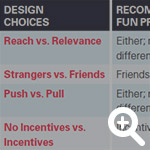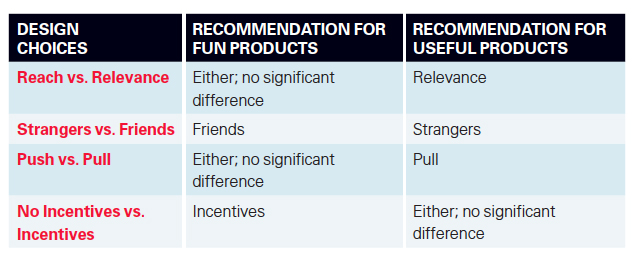Customizing Social Media Marketing
Are your company’s products primarily useful — or fun? Recent research suggests that the answer to that question should guide your approach to social media marketing campaigns.
As the number of social media users continues to climb, many companies are looking beyond simply establishing a social presence — and are seeking to “get social media marketing right.” The prospect of free, yet effective viral marketing recommendations from consumer to consumer is very appealing — but often elusive.
Through an analysis of the success of 751 social media marketing campaigns involving Facebook apps, we investigated the social sharing mechanisms that encourage consumers to share information about a product with their friends. What we found is that there is no easy, one-size-fits-all solution for social media marketing. Instead, companies must tailor their social media marketing strategies to fit their products. In particular, useful products benefit from different social media marketing approaches than do fun products such as games.
On social media platforms such as Facebook, the design of the social sharing mechanism intended to encourage consumers to share viral messages is crucial. Consumers can learn about their friends’ interests in several ways: via publicly shared timeline messages, via direct private messages or from the “about” section of their friends’ personal profile pages. When designing the optimal social sharing mechanism for Facebook, managers must make four decisions:
Reach vs. Relevance
A social sharing mechanism can either rely on broadcast messages or target friends individually. Choosing one over the other involves trade-offs between greater reach on the one hand and higher relevance of the shared message on the other. The majority of the Facebook campaigns we studied favored broadcast messages (64%) over individual targeting (36%).
Choosing the Right Social Sharing Mechanisms
The optimal design choices for social sharing mechanisms for utilitarian products are different from those for fun products.
Strangers vs. Friends
In social networks, most information sharing occurs between direct friends. On Facebook, consumers can also reach second-degree contacts with whom they have no direct connection through comments posted on their friends’ timelines. When designing a social sharing mechanism, managers must decide whether it should be targeted at friends or second-degree contacts who may be strangers. Whether recommendations from direct friends are always more influential than recommendations from strangers is an open question. However, of the Facebook campaigns we observed in our study, only 7% were aimed at strangers.
Push vs. Pull
Social media users receive many recommendations without explicitly asking for them through, for example, unsolicited direct or broadcast “push” messages. Other social sharing mechanisms that rely on “pull” messages that consumers seek out — such as when a consumer actively searches for information about things his or her friends “like” on their profile pages — are rare in comparison. In traditional company-to-consumer communication, unsolicited messages are often referred to as spam, and their reduced effectiveness compared to solicited messages is well documented; in social sharing, the verdict on unsolicited messages is still out. Still, almost two-thirds (64%) of the Facebook campaigns we studied were willing to take the risk of relying on unsolicited messages pushed to consumers.
No incentives vs. Incentives
In 11% of the campaigns we studied, social recommendations came with an incentive to use the product. Incentives may be in the form of virtual or in-app goodies, coupons or rebates for physical products, or free premium services. Most of the time, incentives come at a cost to the company; however, whether incentives always provide a measurable benefit is unclear.
To investigate the effect of these four design decisions on the promotion of fun and useful products, we carried out an empirical study based on 751 Facebook apps from 22 product categories, including games, entertainment, business and money. In each category, our sample included the top 20 apps, as well as a random selection of remaining apps. To analyze success, we relied on daily information about the number of installations for each app, but we also replicated our results with alternative success measures, such as the number of daily active users. As part of our study, human raters looked at each app and manually coded information about its social media campaign, including information about app quality (in the form of number of fans and reviews) and whether the usefulness of the app increases if friends also use it. This information allowed us to rule out alternative drivers of app success. (Detailed findings from our study were reported in the Journal of Marketing. See “Related Research.”)
Facebook apps are an ideal study setting, in that they spread primarily through viral marketing. At the same time, the success of an app is often directly linked to the success of an underlying “real-world” product (for example, Spotify or Skype), which makes the results applicable to products beyond apps. Similarly, our results likely hold for fun- and entertainment-oriented social media platforms in general, even though our empirical study focused on Facebook.
Tailoring a Campaign
When managers decide on the design of the social sharing mechanism for their social media campaign, they must consider two things: the type of product they are promoting (is it a fun product or is it primarily useful?) and the nature of the platform they will use for the campaign. Facebook, for example, is seen by most consumers as a platform for fun and entertainment. As a result, Facebook users’ reactions to social recommendations will differ depending on whether the product’s purpose fits their expectation. Consumers expect to encounter messages about fun products on platforms like Facebook, so upon receiving such messages, they may be willing to invest some time and effort into determining their interest in the particular product. In contrast, they will only glance over recommendations for useful products and rely more on social cues and heuristics to assess those products’ merits. Consumers’ reactions differ, and so should the social sharing mechanisms used to promote these products.
Social Media Marketing for Fun Products
After analyzing hundreds of social media campaigns on Facebook, we found that the social sharing mechanism that games such as FarmVille made famous — broadcast messages from friends that contain incentives to try the product — is the most effective social sharing mechanism for fun products on Facebook. Our findings indicate that the reach of the average fun product will increase by a factor of 19 with the help of incentivized timeline posts from friends.
For fun products, broadcast messages are as effective as direct messages. Apparently, receivers of messages for fun products do not regard broadcast messages as largely irrelevant. Unsolicited messages from friends about fun products have a greater impact than similar messages from strangers; we seem to trust our friends more when it comes to fun and entertainment. Unsolicited messages about fun products seem to be okay on Facebook, because the recommendation does not come directly from a company and meets the consumers’ general interest. The most important sharing component for fun products, however, is incentives.
Social Media Marketing for Useful Products
However, when marketing useful products on Facebook, the recipes for fun products no longer work. Perhaps because consumers do not visit Facebook to hear about useful products, we found that aggressive unsolicited broadcast messages from friends will even decrease campaign reach! Our research suggests that to be successful, social media marketing for useful products could instead rely on more subtle promotion in the “likes” section on consumers’ “about” pages or on more relevant direct messages between friends.
When consumers receive viral messages from their friends about useful products, relevance beats reach. “This product isn’t fun; my friend would have sent me a direct personal message if it was truly relevant for me,” seems to be a common line of reasoning among consumers who receive broadcast messages about useful products from friends. Interestingly, broadcast messages from friends for useful products are not only less effective than direct messages from friends, but also less effective than similar broadcast messages from strangers. When evaluating a useful product, consumers seem to value objective recommendations from outside their own social group more than recommendations from their friends. Because Facebook users visit the platform for fun and entertainment, their tolerance for unsolicited messages about useful products is low; messages they seek by reading on their friends’ Facebook profile pages about products those friends “like” or use are much more effective in comparison. Finally, incentives have a neutral effect for promoting useful products.
Social media marketing is still a new marketing instrument and, compared to traditional television and print advertising, we still know very little about how it works. At the same time, its huge audience makes social media a potentially powerful tool to reach many consumers at relatively low cost. Our research shows that the key to successful social media marketing lies in customizing the campaign to the product, and that might even involve a deliberate decision not to include common social sharing mechanisms, such as timeline posts from friends that contain incentives. Many well-known success stories illustrate what our research confirms: Well-designed social media campaigns can be a powerful tool. However, managers must be careful: Choosing the wrong kind of social sharing mechanisms for your product can stymie your social marketing campaign.


 View Exhibit
View Exhibit
Comments (7)
Yildirim Sertbas
edward white
vishal kumar
bs srikanth
Mark Suares
BONNIE NELSON
vik